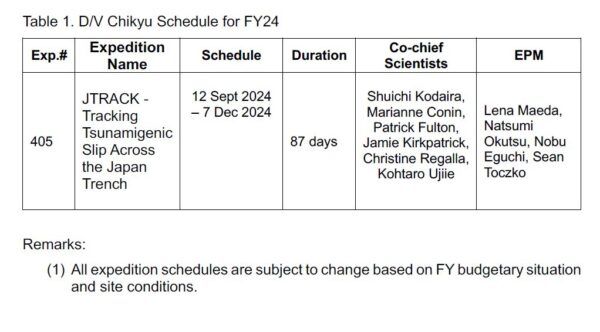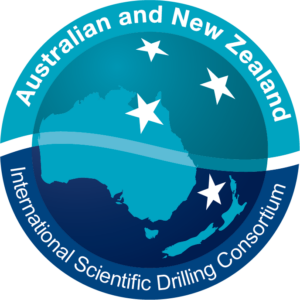
IODP Expedition 405: JTRACK
Tracking Tsunamigenic Slip Across the Japan Trench
Sailing 12 September to 7 December 2024
Applications CLOSED.
We are assessing applications and making preparations.
MarE3 currently plans to implement IODP Expedition 405: JTRACK – Tracking Tsunamigenic Slip Across the Japan Trench.
IODP Expedition 405 will visit two sites (Figure 1) that comprise a transect across the trench from undisturbed sedimentary rocks on the Pacific Plate (JTCT-02A) to a site within the overriding plate that will access the fault zone in the region of large, shallow slip in
the 2011 Tohoku-oki earthquake (JTCT-01A). Site JTCT-01A is located ~6 km landward of the trench, in the frontal prism, and is co-located with IODP Exp 343 site C0019 (Figure 1). Site JTCT-02A is located on the incoming plate, ~8 km seaward of the trench. LWD and coring operations at this site will provide critical information on the physical, chemical, and mechanical properties of input materials to the subduction
zone, as well as on the amount of fluids entering into the subduction zone.
Scientific Objectives of the expedition
The overall goal of Expedition 405 is to establish the properties, processes, and conditions within subduction zones that promote large slip to the trench and contribute toward the generation of large tsunamis.
To meet this goal, Expedition 405 will undertake a coordinated strategy of LWD, coring, and observatory installation to achieve a series of objectives that together will develop a comprehensive description of the mechanical properties and conditions relevant to earthquake slip: 1) the stress and strain conditions within and around the fault zone and their variation over space and time, 2) the subsurface geology including the physical rock properties affecting fault slip behavior and strain , as well as the geologic record of past earthquakes and tsunami, 3) the hydrogeology of the fault zone – including the hydrogeologic structure of faults, fractures, and permeable zones around the plate boundary and their influence on effective stress and earthquake mechanics and the variation of conditions over time.
Secondary science objectives include carrying out other geological, geochemical, and microbiological observations to the greatest extent possible during drilling in accordance with the D/V Chikyu Standard Measurements Document.
Please read the Expedition 405 Prospectus for further details.
Webinar
You can find the webinar with details and answers to questions here.
Operation Plan
The operational sequence to be completed during IODP Expedition 405 consists of:
1. Drilling an 8-1/2-inch hole with logging while drilling (LWD)/measurement while drilling (MWD)
to total depth (TD), currently planned for 950 mbsf at Site JTCT-01A and 450 mbsf at Site JTCT-02A
2. Coring a 10-5/8-inch hole with the Rotary Core Barrel (RCB) system to 950 mbsf at Site JTCT-01A
and to 450 mbsf at Site JTCT-02A.
3. Jetting a 20-inch casing and wellhead, drilling 10-5/8-inch hole to 950 mbsf and installing
4-1/2” Tubing (TBG) with multisensor temperature measurement string at Site JTCT-01A.
Expedition Schedule
Current plans have the expedition beginning on 12 September 2024, and finishing upon return to port on 7 December 2024. This schedule is subject to change. Updates and the latest information can be found on the MarE3 website (https://www.jamstec.go.jp/chikyu/e/exp405/). The total number of planned offshore operations days will be 87 days. The Science Party will be divided into two teams. Each team will consist of about 10~25 scientists and will be onboard around 6~7 weeks. The Expedition Co-chiefs and PCT members will assign scientists for each window, based on the science targets outlined in their science plans for the expedition. The onboard Science party members will embark and disembark by helicopter thus the OPITO approved Helicopter Underwater Escape Training (HUET) certificate is required for all onboard science party members.
Science Party
Scientists with interest and expertise in faulting and earthquake mechanics, stress in the crust, physical and mechanical rock properties, thermal and hydrogeologic properties, processes, and conditions, and their evolution over time, fluid geochemistry and deep subsurface biology, fault zone geology and core-log-seismic integration (CLSI) in structurally-complex settings, sedimentology, and borehole instrumentation are invited to apply. Shipboard duties will likely include sedimentology/lithostratigraphy, structural geology, physical properties, observatory installation and in situ stress, log analysis and core-log-seismic integration, paleomagnetism,
microbiology, micropaleontology, geochemistry (organic and inorganic).


NOTE: ANZIC participation in IODP Expedition 405 JTRACK is subject to negotiation with JAMSTEC/MarE3.
